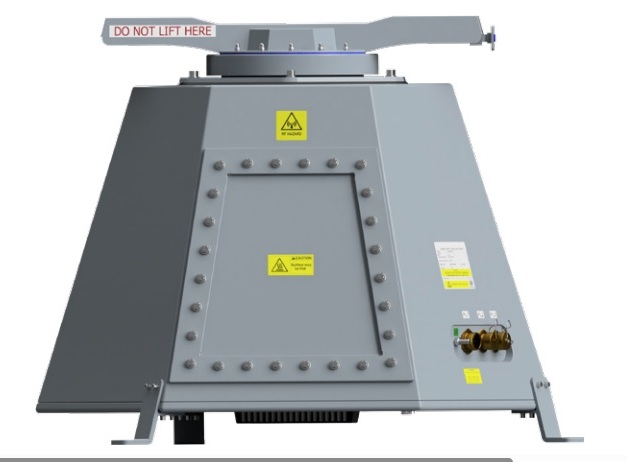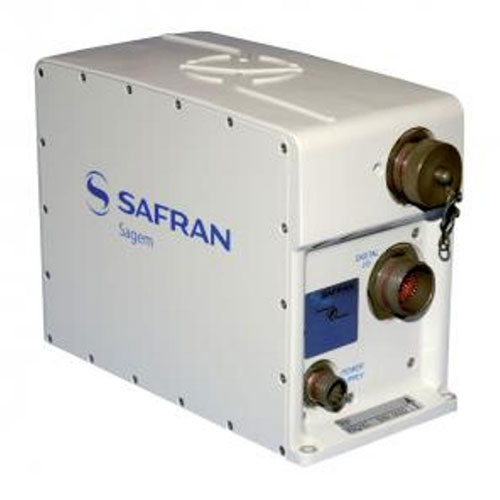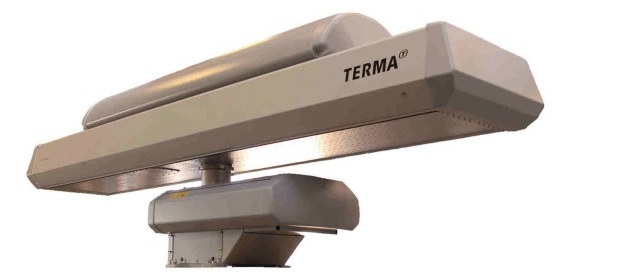 |
| The Harry DeWolf, AOPV 430, under construction. (A Shipsforcanada.ca photo) |
INTRODUCTIONFirstly, the two acronyms AOPS and and AOPV need to be understood.
Arctic and Offshore Patrol Ship (note the singular) is the project name. Arctic and Offshore Patrol Vessels is what the RCN has designated as the ship type. They are both valid but each is best used where the distinction applies, i.e., AOPS when writing about the building and AOPV when writing about RCN employment and ship operations. Naval HQ are preferring the use of AOPS at this time. It is understand from them that senior bureaucrats and politicians are struggling with the AOPS-AOPV distinction at this time. Theoretically AOPS should go away when the project is stood down. Of course, sailors being what they/are, will still refer to the ships as AOPS when AOPV is actually meant.
As of October 2018, rhere are Arctic and Offshore Patrol Vessels of the Harry DeWolf-class being built out of a total of five ordered: Harry DeWolf, Margaret Brooke and Max Bernays. All are under construction at Irving's Halifax Shipyard. Steel cutting for the fourth AOPV, the future HMCS William Hall, is anticipated soon. Dewolf was launched by being floated from a semi-submersible barge on 15 September 2018, and her naming ceremony took place on 5 October 2018 Later ships will be Frédérick Rolette and, if and likely contracted, Robert Hampton Gray. In the past, the launch and naming ceremony took place at the same time and place. With block construction, they are now separate.
| NAME OF SHIP | PENNANT | LAUNCHED | STATUS | RADIO CALLSIGN |
| Harry Dewolf | AOPV 430 | 15 September, 2018 | Comissioned 26 June, 2021 | CGBT |
| Margaret Brooke | AOPV 431 | November 2019 | Com,issioned 27October, 2022 | CGMB |
| Max Bernays | AOPV 432 | 23 October 2021 | Commissioned 2 May ,2024 | CGBH |
| William Hall | AOPV 433 | 27 November 2022 | Commissioned 16 May 2024 | CGWH |
| Frédérick Rolette | AOPV 434 | 9 December 2023 | Comissioned June 13/25 | CGFR |
| Robert Hampton Gray | AOPV 435 | 9 December 2024 | Comissioned early Aug/2025 | CGRG(?) |
BACKGROUNDER ON THE CLASSThe Future HMCS Harry DeWolf Naming Ceremony
From Navy News / October 2, 2018On September 18, 2014, the Government of Canada announced the Royal Canadian Navy’s new class would be known as the Harry DeWolf class. The future Her Majesty’s Canadian Ship Harry DeWolf is named in honour of the celebrated wartime Canadian naval hero, Vice-Admiral Harry DeWolf.
The Harry DeWolf class will enhance the RCN’s ability to assert Canadian sovereignty in Arctic and coastal Canadian waters, and support international operations as required. This is the first time in its 108-year history that the RCN is naming a class after a prominent Canadian Navy figure. The remainder in the class will be named to honour other prominent Royal Canadian Navy heroes who served their country with the highest distinction: Margaret Brooke; Max Bernays; William Hall; and Frédérick Rolette.
The Harry DeWolf-class tasks will include, but are not limited to:
• Conduct presence and surveillance operations throughout Canada’s waters, including in the Arctic;
• Support Canadian Armed Forces in sovereignty operations;
• Participate in a wide variety of international operations, such as anti-smuggling, anti-piracy, and international security and stability;
• Contribute to humanitarian assistance, emergency response, and disaster relief domestically and internationally;
• Conduct search and rescue and provide communications relay to other units as required;
• Support CAF core missions, including capacity building in support of other nations; and,
• Support Other Government Departments in their ability to enforce their respective mandates.Terminology
* First Launch: When a ship is moved from shore to water for the first time. The future HMCS Harry DeWolf was successfully lowered into the water under controlled circumstances.
* Naming Ceremony (formerly known as christening): A key milestone in a warship’s service life, this is the formal occasion when the name is bestowed.
*Sponsor: A person selected for her or his relationship to the ship’s namesake or role and who typically maintains a long term relationship with the ship and ship’s company. As the sponsor of the future HMCS Harry DeWolf, Madame Sophie Grégoire-Trudeau will break a bottle of sparkling wine on the ship’s bow to bestow good luck and to offer a brief statement or blessing for the ship and ship’s company.
* Acceptance: The acceptance of the future HMCS Harry DeWolf will follow a designated number of trials (approximately one year long). The Harry DeWolf will undergo rigorous, incremental testing to ensure it meets all requirements.
* Commissioning Ceremony: The ceremony, steeped in naval tradition, marks the formal acceptance of a warship into active service as part of the Royal Canadian Navy. At this point the vessel is entitled to the designation Her Majesty’s Canadian Ship.
 |
| The Harry DeWolf, AOPV 430, under construction. (A Shipsforcanada.ca photo) |
GENERAL SPECIFICATIONSType: Patrol vessel
Class: AOPV
Displacement: 6,440 metric tonnes
Length: 103.6 m (340 ft)
Beam: 19 m (62 ft)
Installed power: Four 3.6 MW (4,800 hp) generators
Propulsion: Diesel electric; two shafts (2 × 4.5 MW (6,000 hp))
Speed: 17 knots (31 km/h; 20 mph) (open water)
3 knots (5.6 km/h; 3.5 mph) (icebreaking)
Range: 6,800 nautical miles (12,600 km)
Crew complement: 65SENSORS and PROCESSING SYSTEMS
* AESA radat (Active Electronically Scanned Array). In the AESA, each antenna element is connected to a small solid-state transmit/receive module (TRM) under the control of a computer, which performs the functions of a transmitter and/or receiver for the antenna. AESA is a type of phased array antenna It is a computer-controlled antenna array in which the beam of radio waves can be electronically steered to point in different directions without moving the antenna.
* MESA Surveillance Radar (Multi-Role Electronically Scanned Array)
* Kelvin Hughes SharpEye Mk 11 combined navigation and naval surveillance radar. Operates in the X and S-bands. Power levels : 300 watts on X-Band and 200 watts on S Band. Can detect targets as small as 0.5 square meter in a cluttered environment over several nautical miles.
 |
| Sharpeye Mk 11 (Image by Kelvin-Hughes) |
* SATCOM (Link 16). Link 16 enables military aircraft, ships, and ground forces to exchange their tactical picture in near-real time.Ii also supports the exchange of text messages, imagery, and voice (the latter on two digital channels: 2.4 kbit/s or 16 kbit/s in any combination).*Multichannel VHF radio (make unknown)
*U/HF radios (make unlnown)
*Anti-missile detection systems (no details available).
*Thales BlueGate Long Range IFF interrogator and transponder
Thales IFF transponder (Image via Thales) *Sonar. - During HMCS Harry DeWolf’s participation on Operation Nanook 2021, a team from Defence Research and Development Canada (DRDC) launched a new underwater listening device used to find submarines. Called the Towed Reelable Active-Passive Sonar (TRAPS), the system recorded passive data to characterize ambient noise and the Harry DeWolf-class acoustic signature. The collected data was analyzed for environmental characterization and sonar performance modelling, and may have the potential to be used for marine mammal acoustic monitoring
*SAGEM (Integrated Bridge Navigational System), The Integrated Bridge Navigational System is actually provided by OSI and SAGEM provided the Inertial Navigation System to OSI for inclusion in the IBNS. The SAGEM INS is very cool technology – a Hemispheric Resonant Gyro. In September 2015, it was announced that the ships would be outfitted with SAGEM BlueNaute navigational systems. Sagem (Safran) has won the contract from OSI Maritime Systems Ltd. against an international field of bidders, to provide the inertial navigation systems for the Royal Canadian Navy's six Harry DeWolf class offshore patrol vessels. Each of these arctic patrol boats will be outfitted with two BlueNaute® attitude and heading systems from Sagem. The new-generation BlueNaute® system is based on a proprietary Sagem technology, the hemispherical resonator gyro (HRG). Initially used for space applications, this technology offer a major improvement in terms of maintenance and total cost of ownership compared with previous generation navigation systems. The BlueNaute® system is capable of operating in the harshest environments, which means that it is ideally suited for the long-duration missions in arctic zone
 |
| SAGEM BlueNaute navigational systems is capable of operating in the harshest environments.(Photo via Defalya.com) |
* TERMA currently provides its SCANTER 6002 radar system to Lockheed Martin Canada as part of the Combat Management System (CMS 330), which was selected by Irving Shipbuilding Inc. for the Arctic and Offshore Patrol Ships. It is capable of monitoring the near airspace out to 10- 14 nm and an altituse of 6,000 feet.
 |
| This is the DBHG (Dual Beam High Gain ) antenna for the Scanter 6002 radar. It can also come with an optional IFF capability. (Photo by TREMA A/S) |
* During HMCS Harry DeWolf’s participation on Operation Nanook 2021, a team from Defence Research and Development Canada (DRDC) launched a new underwater listening device used to find submarines. Called the Towed Reelable Active-Passive Sonar (TRAPS), the system recorded passive data to characterize ambient noise and the Harry DeWolf-class acoustic signature. Its deteection range is 150 km. The collected data will be analyzed for environmental characterization and sonar performance modelling, and may have the potential to be used for marine mammal acoustic monitoring.
ARMAMENT:
1 × BAE Mk 38 25 mm gun
2 × M2 Browning machine gun
Aircraft carried:
Sikorsky CH-148 Cyclone, or
Bell CH-146 GriffonELECTRICAL SYSTEM
From Maritime Engineering Journal Fall 2022.
"The AOPV has four diesel-alternators sets coupled to two main high voltage 6,600 VAC switchboards for primary electric power generation. Each high voltage switchboard supplies 6,600VAC, 3-phase, 60 Hz power to one of two ship's service transformers, of which only one is required during normal operation to supply the full service electrical load.
The ship service transformers convert the high voltage power to a low voltage (LV) 465 VAC, 3 phase, 60 Hz power for use in ship-wide systems via one of two ship service 440 VAC switchboards. Various transformers are used throughout the ship to convert power to 440, 220, or 120 VAC to support specific ship service systems. A 440 VAC emergency switchboard is also fitted, supplied from either one of the 440 VAC service switchboards, one of two shore power panels, or the emergency diesel alternator.
The emergency switchboard provides power to all emergency power consumers, or to provide power to all ship servicesystems when under shore power. The emergency diesel alternator is fitted to provide initial starting energy to propulsion machinery within 30 seconds of a dead ship. It is able to carry its nominal full-rated load within a maximum of 45 seconds. The emergency diesel alternator is a four-stroke, non-reversible, turbocharged, and inter-cooled Caterpillar 3512C diesel engine with direct fuel-injection. The engine has a 60-egree V-12 configuration, with four valves per cylinder, and a cold start capability. The engine is coupled to an OV2319 Kato AC brushless revolving field generator that is rated to produce 1360 kW of 440 VAC, 3 phase, 60 Hz at a maximum engine speed of 1800 rpm. The emergency diesel-alternator can be brought online in parallel with main ship service power, or shore power, to implement a make-before-break energization strategy that allows for a transfer of power without blackout".
| MISCELLANEOUS |
| APOV Underway - An artist's conception. (Image courtesy RCN) |
| Harry DeWolf Badge |
| Harry DeWolf Ball Cap |
Credits and References:1) http://shipsforcanada.ca/our-stories/first-arctic-and-offshore-patrol-ship-ass
embled-at-halifax-shipyard
2) https://en.wikipedia.org/wiki/Harry_DeWolf-class_offshore_patrol_vessel
3) Maritime Engineering Journal TRAPS Fall 2022
4) Scanter 6002 document, https://fcc.report/FCC-ID/N9MSC5000/4479597.pdf
5) TERMA www.terma.com
6) AESA https://en.wikipedia.org/wiki/Active_electronically_scanned_array
7) Sharp Eye https://www.hensoldt.net/products/kelvin-hughes-mk11-sharpeye-combined-navigation-and-naval-surveillance-radar
8) https://www.canada.ca/content/dam/dnd-mdn/documents/mej/42-071-maritime-engineering-journal-102.pdf
Mar 30/25 Back to Table of Contents